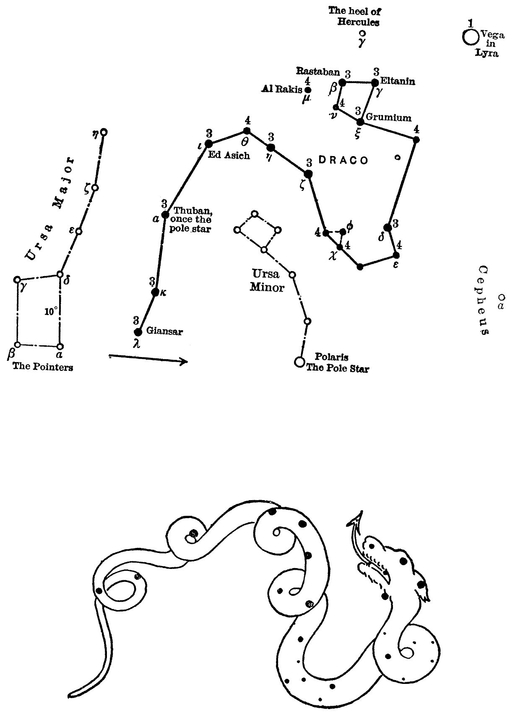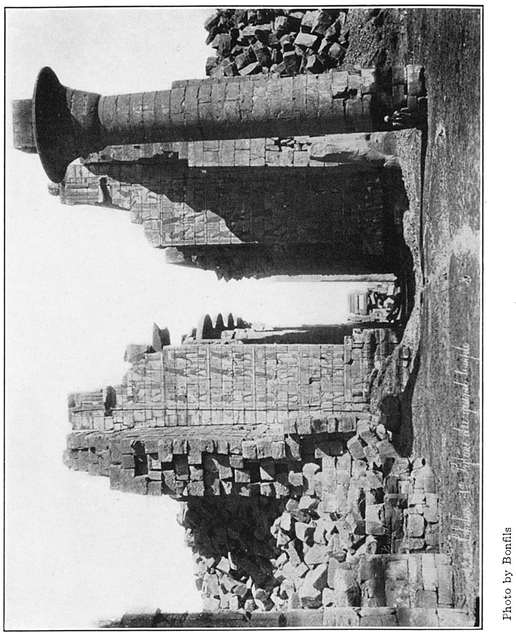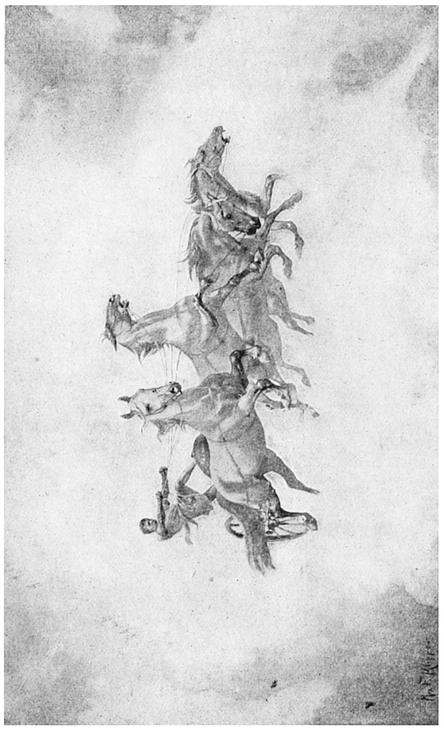Draco
The Dragon

DRACO
DRACO
THE DRAGON
Here the vast Dragon twines
Between the Bears and like a river winds.
WARTON’S Virgil.
THERE is no doubt that Draco dates from the earliest times, as Eudoxus and Aratos both mention this constellation, and many believe that it represents the crooked serpent of Job xxvi., 13.
Of all creatures the serpent is historically the most interesting. It is referred to in myth and legend more often than any other, and connected as it is with the very story of Eden, it is linked with the earliest history of man as no other creature is. That it should have found a place amid the constellations is a matter of course, but it seems strange that a creature abhorred instinctively by men of all ages should have been so highly esteemed by the inventors of the constellations as to have been placed by them at the very throne of the heavens.
Burritt says: “Whoever attends to the situation of Draco, surrounding as it does the pole of the ecliptic, will perceive that its tortuous windings are symbolical of the oblique course of the stars. Draco also winds around the pole of the world as if to indicate in the symbolical language of Egyptian astronomy the motion of the pole of the equator around the pole of the ecliptic produced by the precession of the heavens. ”
In all probability, the twelve signs of the zodiac were the first star groups to be mapped out. The northern stars next claimed attention, and according to Irving,22 out of these stars was traced a great winged dragon which was supposed to guard the pole of the heavens. In after years the precession of the equinoxes forced the creature off the pole, and he was said to have been overcome by the stalwart Michael, and thrown into a bottomless pit. One writer says: “His tail drew the third part of the stars of heaven, and did cast them to the earth.”
The Egyptian hieroglyph for the heavens was a serpent whose scales denoted the stars. When astronomy first began to be cultivated in Chaldea, Draco was the polar constellation.
“It is not known just why this constellation got its fearsome symbol,” says Maunder; “the dragon or snake was amongst all ancient nations used to symbolise the powers of evil or darkness or of chaos, but this gives us no explanation why a constellation far from being the least beautiful and conspicuous has been chosen to convey the idea of darkness, still less why such a symbol should have been planted at the very crown of the celestial sphere.”
To the early Chaldeans the body of Draco was probably much larger than is now conceded. It surrounded both Bears, and extended downward and in front of Ursa Major.
The Babylonians regarded Draco as a monster personifying primeval chaos—a monster that was finally overcome by a great wind, which was driven with such force into his open jaws that it split him in two.
Brown claims that this constellation is Phoenician in origin, and represents primarily the old serpent, the tempter of Eve in the Garden. Dr. Seiss takes this views of it also.
Mythological accounts of Draco vary considerably. By some this serpent is the guardian of the stars (the golden apples) which hang from the Pole tree in the Garden of Darkness, or Garden in the West, the Garden of Hesperides, near Mount Atlas in Africa.
In north temperate latitudes this constellation never sets, and the Greeks therefore saw in it an emblem of eternal vigilance, symbolised by this Dragon of the Garden, guarding the precious fruit. Juno, it is said, presented these golden apples to Jupiter on the day of their nuptials, and rewarded Draco for his faithful services by placing him among the stars. The legend relates that the serpent was slain by Hercules, and in the old maps Hercules is represented as crushing the head of the Dragon under his foot.
Others claim that this was the snake snatched by Minerva from the giants, and whirled to the sky before it had a chance to uncoil, and that thus twisted it sleeps to-day in the heavens around the axes of the world.
According to another story this is the dragon killed by Cadmus, who was ordered by his father to go in quest of his sister Europa, whom Jupiter had carried away, and never to return to Phoenicia without her. Cadmus having slain the dragon, sowed its teeth and reaped a crop of armed men, who presently engaged in mortal combat from which five only survived. These assisted Cadmus to build the city of Boeotia.
There is an allusion to the Dragon in connection with the familiar story of Phaeton and his desperate adventure with the steeds of day: “When Phaeton rode the chariot of the sun, the horses rushed headlong. Then for the first time the Great and Little Bears were scorched with heat and would fain if it were possible have plunged into the water, and the serpent (Draco) which coils around the North Pole, torpid and harmless, grew warm, and with warmth felt his rage revive.”
In Egypt the Dragon was called “Typhon.” Plutarch tells us that the hippopotamus, or its variant the crocodile, was certainly one of the forms of Typhon. On the planisphere of Denderah, and the walls of the Ramesseum at Thebes, these animals appear in the circumpolar region, and show clearly that they owe their position to the old myth that the rising sun destroys the circumpolar stars; and Horus, the great god, the light of the heavens, is represented as destroying the hippopotamus or crocodile or Draco. The same idea has come down to us in the well-known myth of St. George and the Dragon.
In Greece Draco was called “Pytho”; in India “Kalli Nagu,” meaning the banishment of Vishnu. In Anglo-Saxon chronicles he is referred to as “the fire drake,” “the denier of God,” “the unsleeping poison-fanged monster, ” and “ the terrible enemy of man full of subtility and power. ” “The Dragon wing of night overspreads the earth” is an expression which shows the effect of imagination when aroused by the story of such monsters.
There seems to have been a special effort on the part of the originators of the constellations, at the outset almost, to symbolise by a star group the presence of the Evil One, ever watchful, ever vigilant, gazing down upon mortals from the high heavens, as a perpetual menace to evil-doers and a continual reminder of original sin.
The constellations Draco and Hercules are closely associated in ancient mythology, and Hercules is always represented as trampling the Dragon underfoot. These two constellations are in turn connected with Ophiuchus and Serpens, the figure of another giant overcoming a serpent, while he crushes the Scorpion under his feet. On the old maps the figures of these two famous giants appear head to head.
These similar and striking groups, placed so close together in the sky, show clearly that there was a deliberate intention on the part of the inventors of the constellations to emphasise the great fact of a struggle between mankind and serpentkind. There seems here an evident reference to God’s interview with the serpent in the Garden of Eden. “I will put enmity between thee and the woman, and between thy seed and her seed. It shall bruise thy head and thou shalt bruise his heel.”
There can be little doubt that in these star groups we have evidence of the very earliest attempts of man to engrave a record of history and tradition for all humanity to read, and that in the history of these constellations lies the key to many of the mooted religious questions of the day.
The Arabs knew Draco as “Al-Tinnin,” and “Al-Thuban,” and had names for all the brighter stars in the constellation, many of which represented to their imagination goats or camels. The Egyptians, it is said, also called Draco “Tanen” at one time. This name is still retained by the star ϒ Draconis.
The dragon was the national emblem of China, but, strange to say, the Dragon of the Chinese zodiac was among the stars composing the constellation Libra. According to Edkins, “the Palace of the Heavenly Emperor” is bounded by the oval formed by the fifteen stars in Draco, amongst which is the star “Tai-yi,” the ancient Pole Star, twenty-two degrees from the present Pole.
Schiller thought Draco represented the Innocents, other early Christians saw here the Dragon Infernal.
There are several stars in this constellation that are noteworthy. α Draconis, called by the Arabs “Thub n” and “Al-Tinn
n” and “Al-Tinn n,” was in the year 2790 B.C., or thereabouts, the Pole Star, and the whole constellation then swung around it as on a pivot. Hence it was known in China as “the Right Hand Pivot. ”
n,” was in the year 2790 B.C., or thereabouts, the Pole Star, and the whole constellation then swung around it as on a pivot. Hence it was known in China as “the Right Hand Pivot. ”
The change in the position of the Pole Star is of such interest, that a slight reference to the reason for it is worth noting. The north celestial Pole is slowly moving in a small circle whose centre is the north Pole of the ecliptic, that great circle which the sun, moon, and planets traverse. This motion causes what is known as “the Precession of the Equinoxes,” by which they travel slowly westward, completing an entire revolution in 25,900 years. This motion also causes in time a change in the Pole Star, so that even as Thuban once was, and Polaris now is, so Vega in 13,000 years will mark the Pole.
The importance of the star Alpha Draconis to the ancients is evidenced by the many titles bestowed on it, a few of which are here given: “ Judge of Heaven,” “High Horned One,” “Proclaimer of Light,” “High One of the Enclosure of Life,” “The Favourable Judge,” “Life of Heaven,” “the Prosperous Judge,” “Crown of Heaven.” Seamen regarded it as the Dragon’s tail, and Al-Tizini called it “the Male Hyena.”
The Great Pyramid was oriented to Thuban, the light from which shone down its central passage in the year 2170 B.C.
According to Maunder, Thuban marked the Pole at the time the constellations were mapped out, a prominence it must have held for over two thousand years. At that time this star must have seemed to all ordinary observation an absolutely fixed centre round which all the other stars revolved, just as Polaris appears to us now. It was however much closer to the true Pole of the heavens than Polaris is at the present time.
Thuban is a 3.6 magnitude star, pale yellow in colour. Herschel claimed that it was formerly a much brighter star than now. With Bayer it was a second magnitude star, and he assigned to it the first letter of the Greek alphabet. It culminates at 9 P.M., June 7th.
ϒ Draconis, called by the Arabs “ Eltanin,” the “ Dragon’s head,” vies with Thuban in interest, and has been a notable and much observed star in all ages. It was an object of temple worship in early Egypt, where it was called “Isis.” The central passages of the temples of Hathor at Denderah, and that of Thut at Thebes, were oriented to it, the former about 3500 B.C. Long afterwards it served for the orientation of the great temple at Karnak. According to Lockyer, seven other temples were oriented to it, and he considers that the Egyptian goddesses Apet, Mut, Taurt, and Sekhet were the same goddesses under different names, and symbolised the star ϒ Draconis.1
1Referring to the matter of orientation Serviss writes: “There is

Temple of Thebes

Phaëthon Driving the Chariot of Apollo Painting by Max Klepper
Dr. Hooke observed Eltanin with his telescope in the daytime in 1669, but its chief interest lies in the fact that the observation of it led Bradley in 1725 to discover the laws of the aberration of light.
Allen cites the following interesting facts respecting Eltanin: The Bœotian Thebes, the city of the dragon, from the story of its founder Cadmus, shared with its Egyptian namesake the worship of this star in a temple dedicated about 1130 B.C. Eltanin lies almost exactly in the zenith of Greenwich, and hence it has been called “the zenith star.” It has been observed at Greenwich for more than two hundred years.
ν Draconis is an interesting double star, separable with a field-glass of high power, the distance of the components being almost exactly one minute of arc.
The remaining stars in the constellation are of no special interest though their many titles are evidence of the great importance of this constellation to the ancients.